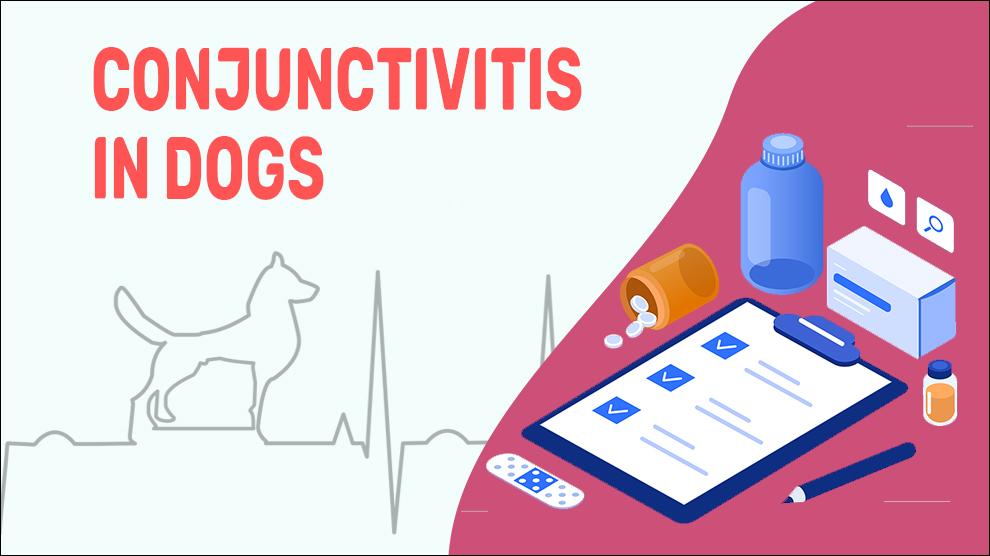What Is Conjunctivitis In Dogs?
Conjunctivitis is characterized by inflammation of the conjunctiva - the membranous tissue that lines the inside of the eyelids and the sclera of the eye. Commonly referred to as ‘Redness In Eyes’, this condition is due to the swelling of the mucous membranes, as they become itchy, and turn brighter red or pink due to the inflammation of conjunctiva for various reasons.
The cause of Conjunctivitis in dogs is attributable to congenital, infectious, idiopathic, metabolic, neurogenic, drug-induced, iatrogenic, radiation, and immune-mediated (the most prevalent form in dogs).
Bacterial conjunctivitis is often confused with keratoconjunctivitis sicca. When wrongly treated with topical antibiotics used to treat bacterial infections, the pet improves initially but the clinical signs resurface after the discontinuation of the treatment. If left untreated or not properly treated, the condition progresses to corneal opacification leading to blindness.
Conjunctivitis may be a primary or secondary problem and it affects one or both eyes.
Symptoms Of Conjunctivitis In Dogs
- Redness, swelling, and eyes look mois
- Excessive blinking, pawing
- Blepharospasm
- Painful, red, and irritated eyes.
- Prominent nictitans (third eyelid).
- Mucoid to mucopurulent ocular discharge.
- Conjunctival hyperemia
- Corneal ulceration
- Hyperpigmentation
- Corneal perforation
Treatment Options For Conjunctivitis In Dogs
- Allergy conjunctivitis: Anti-inflammatory (prednisolone or dexamethasone) or antihistamine medications.
- Antibiotics such as amoxicillin, chloramphenicol, gentamicin, tobramycin, ciprofloxacin, oxytetracycline, etc.
- Keratoconjunctivitis sicca: Artificial tear drops STT I values: 0 mm/min and 5 - 7 mm/min (once an hour administration). If STT I values are >7 = six times a day.
- Artificial tear drops substitutes are hyaluronic acid, polyvinyl alcohol, polyvinyl pyrrolidine, and methylcellulose.
- Cyclosporine A (CsA), pimecrolimus, and tacrolimus - are noncytotoxic immunosuppressants.
- Acetylcysteine: A mucolytic agent to treat mucin excess on the ocular surface.
- Pilocarpine: Used to treat conjunctivitis with neurogenic origin (parasympathomimetic agent).
Home Remedies For Conjunctivitis In Dogs
- Gently washing the eyelids using baby shampoo and/or applying warm compresses to the eyes can help discharge the oil in the tear glands.
- Add a humidifier to a furnace and/or use a bedside humidifier (especially in cold weather) can bring some moisture back into the dry air.
- Dogs with dry eyes should avoid too much air movement such as usage of fans or in windy areas.
- Pet eye lubricating gels are another option (best to apply at night or before bedtime).
Prevention Of Conjunctivitis In Dogs
The best way to prevent dry eye is to maintain proper eye hygiene with products engineered specifically for dogs and to maintain overall health.
Affected Dog Breeds Of Conjunctivitis
German Shepherd, Collie, Boston Terrier, Bloodhound, Bulldog, Cocker Spaniel, Cavalier King Charles Spaniel, Lhasa Apso, Miniature Schnauzer, Pug, Pekingese, Shih Tzu, Samoyed, Yorkshire Terrier
Additional Facts For Conjunctivitis In Dogs
- Causes:
- Metabolic: Hypothyroidism and diabetes mellitus.
- Infectious: Leishmania, canine distemper virus, etc.
- Drug-induced:
- Temporary: Local or systemic anesthetic, atropine, and sedatives.
- Permanent: Potentiated sulfonamides.
- Neurogenic: Middle-aged female dogs - associated dry/crusted ipsilateral nostrils.
- Tumors of the conjunctiva and eyelids.
- Eyelid abnormalities: Ectropion, entropion, ectopic cilia, and eyelash disorders (distichiasis).
- Iatrogenic: In the case of “cherry eye”, surgical removal of the gland of the third eye.
- Immune-mediated: Plasma cell conjunctivitis, pemphigus, and allergic conjunctivitis.
- Trauma: Accidents, irritation from foreign bodies, environmental pollutants, or smoke.
- Other eye disorders such as keratoconjunctivitis sicca, ulcerative keratitis, glaucoma, and anterior uveitis.
- Types:
There are three main types of conjunctivitis in dogs.
- Allergic Conjunctivitis: This is due to an allergic reaction such as environmental allergens, atopic dermatitis, atopy, etc.
- Viral Conjunctivitis: Canine herpesvirus and canine distemper virus. This usually takes around 3 - 4 weeks to fully resolve.
- Bacterial Conjunctivitis: This can spread to other dogs easily. For instance, Streptococcus or Staphylococcus, chronic dry eye, etc.
- Mortality:
Death due to conjunctivitis in dogs is not yet documented.
- Diagnosis:
- Biomicroscope
- Allergy tests
- Conjunctival cytology or biopsy
- Intraocular pressure testing
- Corneal stain testing
- Prognosis:
The outcome of acute conjunctivitis treatment is excellent. Recurrent and chronic cases may have a guarded prognosis depending on the cause. Many chronic or recurrent cases may need lifelong therapy to control the cause of conjunctivitis but most dogs enjoy a pain-free life with careful attention and monitoring.
If the condition is not diagnosed earlier in the course of the disease or if it has progressed to deep corneal scarring, the pet may lose its vision or may not respond fully to the treatment.
When To See A Vet For Conjunctivitis In Dogs?
Contact your vet right away, if you notice any of the following:
- If your dog blinks excessively or the eyes look painful and red continuously.
- A stringy, ropy discharge to mucopurulent (mucus and pus) ocular discharge.
Food Suggestions For Conjunctivitis In Dogs
- Whole, unprocessed foods
- Low-carb dog food
- Lean meat protein
- Shrimp, Salmon, Tuna, Cod, Halibut, Trout, and Herring fish.
- Blueberries, Broccoli, Carrots.
- Sweet potato, Tomato.
- Leafy green vegetables (lettuce, spinach, salad greens, parsley, collard greens).
Conclusion
For pets with conjunctivitis, early diagnosis with prompt treatment, as well as routine follow-up examinations is of paramount importance. In most dogs, the prognosis can be excellent with the maintenance of vision and long-term comfort.

















